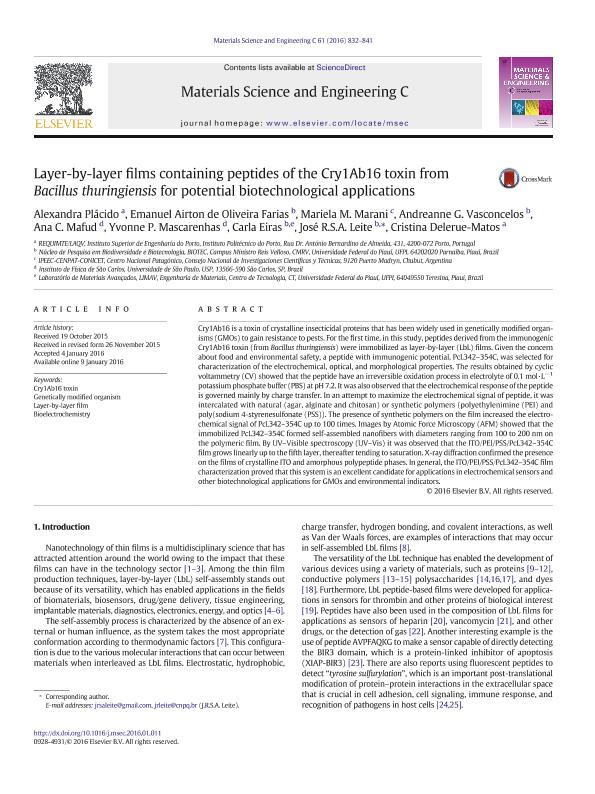Artículo
Layer-by-layer films containing peptides of the Cry1Ab16 toxin from Bacillus thuringiensis for potential biotechnological applications
Plácido, Alexandra; de Oliveira Farias, Emanuel Airton; Marani, Mariela Mirta ; Vasconcelos, Adreanne G.; Mafud, Ana C.; Mascarenhas, Yvonne P.; Eiras, Carla; Leite, José Roberto de Souza Almeida; Delerue Matos, Cristina
; Vasconcelos, Adreanne G.; Mafud, Ana C.; Mascarenhas, Yvonne P.; Eiras, Carla; Leite, José Roberto de Souza Almeida; Delerue Matos, Cristina
 ; Vasconcelos, Adreanne G.; Mafud, Ana C.; Mascarenhas, Yvonne P.; Eiras, Carla; Leite, José Roberto de Souza Almeida; Delerue Matos, Cristina
; Vasconcelos, Adreanne G.; Mafud, Ana C.; Mascarenhas, Yvonne P.; Eiras, Carla; Leite, José Roberto de Souza Almeida; Delerue Matos, Cristina
Fecha de publicación:
04/2016
Editorial:
Elsevier Science
Revista:
Materials Science and Engineering: C
ISSN:
0928-4931
Idioma:
Inglés
Tipo de recurso:
Artículo publicado
Clasificación temática:
Resumen
Cry1Ab16 is a toxin of crystalline insecticidal proteins that has been widely used in genetically modified organisms (GMOs) to gain resistance to pests. For the first time, in this study, peptides derived from the immunogenic Cry1Ab16 toxin (from Bacillus thuringiensis) were immobilized as layer-by-layer (LbL) films. Given the concern about food and environmental safety, a peptide with immunogenic potential, PcL342-354C, was selected for characterization of the electrochemical, optical, and morphological properties. The results obtained by cyclic voltammetry (CV) showed that the peptide have an irreversible oxidation process in electrolyte of 0.1 mol·L- 1 potassium phosphate buffer (PBS) at pH 7.2. It was also observed that the electrochemical response of the peptide is governed mainly by charge transfer. In an attempt to maximize the electrochemical signal of peptide, it was intercalated with natural (agar, alginate and chitosan) or synthetic polymers (polyethylenimine (PEI) and poly(sodium 4-styrenesulfonate (PSS)). The presence of synthetic polymers on the film increased the electrochemical signal of PcL342-354C up to 100 times. Images by Atomic Force Microscopy (AFM) showed that the immobilized PcL342-354C formed self-assembled nanofibers with diameters ranging from 100 to 200 nm on the polymeric film. By UV-Visible spectroscopy (UV-Vis) it was observed that the ITO/PEI/PSS/PcL342-354C film grows linearly up to the fifth layer, thereafter tending to saturation. X-ray diffraction confirmed the presence on the films of crystalline ITO and amorphous polypeptide phases. In general, the ITO/PEI/PSS/PcL342-354C film characterization proved that this system is an excellent candidate for applications in electrochemical sensors and other biotechnological applications for GMOs and environmental indicators.
Archivos asociados
Licencia
Identificadores
Colecciones
Articulos(IPEEC)
Articulos de INSTITUTO PATAGONICO PARA EL ESTUDIO DE LOS ECOSISTEMAS CONTINENTALES
Articulos de INSTITUTO PATAGONICO PARA EL ESTUDIO DE LOS ECOSISTEMAS CONTINENTALES
Citación
Plácido, Alexandra; de Oliveira Farias, Emanuel Airton; Marani, Mariela Mirta; Vasconcelos, Adreanne G.; Mafud, Ana C.; et al.; Layer-by-layer films containing peptides of the Cry1Ab16 toxin from Bacillus thuringiensis for potential biotechnological applications; Elsevier Science; Materials Science and Engineering: C; 61; 4-2016; 832-841
Compartir
Altmétricas



